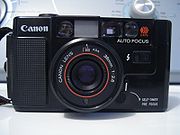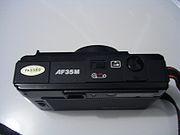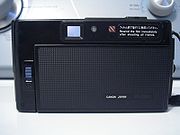
Canon AF35M
Encyclopedia



Autofocus
An autofocus optical system uses a sensor, a control system and a motor to focus fully automatic or on a manually selected point or area. An electronic rangefinder has a display instead of the motor; the adjustment of the optical system has to be done manually until indication...
35mm
135 film
The term 135 was introduced by Kodak in 1934 as a designation for cartridge film wide, specifically for still photography. It quickly grew in popularity, surpassing 120 film by the late 1960s to become the most popular photographic film format...
lens-shutter compact camera. It was launched in November 1979 and received the Japanese Ministry of International Trade and Industry's 1980 Good Design Award in September 1980. It proved successful among similar cameras from the competition and sold well; production reached 110,000 per month by the second half of 1981. It was partly supplanted by 1981's higher-specified AF35ML and wholly replaced by 1983's AF35M II.
The active autofocus system used a near-infrared emitting diode
Light-emitting diode
A light-emitting diode is a semiconductor light source. LEDs are used as indicator lamps in many devices and are increasingly used for other lighting...
and a pin photo diode to determine the subject position by triangulation
Triangulation
In trigonometry and geometry, triangulation is the process of determining the location of a point by measuring angles to it from known points at either end of a fixed baseline, rather than measuring distances to the point directly...
in a manner similar to a coincident-image rangefinder
Rangefinder
A rangefinder is a device that measures distance from the observer to a target, for the purposes of surveying, determining focus in photography, or accurately aiming a weapon. Some devices use active methods to measure ; others measure distance using trigonometry...
. This meant that the system was independent of ambient light levels and achieved a high degree of accuracy; however, it could be fooled by glass (which is not transparent to infrared radiation). The autofocus area was marked on the reverse-Galilean optical viewfinder
Viewfinder
In photography, a viewfinder is what the photographer looks through to compose, and in many cases to focus, the picture. Most viewfinders are separate, and suffer parallax, while the single-lens reflex camera lets the viewfinder use the main optical system. Viewfinders are used in many cameras of...
, which also had projected framelines, zone focusing marks for near, medium and far (lit to indicate the approximate area the autofocus had selected), parallax correction marks, and battery-check and camera-shake warning LEDs. Viewfinder magnification was 0.5× and coverage was 85% of the full 135 frame by area.
The lens was of 38 mm focal length
Focal length
The focal length of an optical system is a measure of how strongly the system converges or diverges light. For an optical system in air, it is the distance over which initially collimated rays are brought to a focus...
and with a maximum aperture
Aperture
In optics, an aperture is a hole or an opening through which light travels. More specifically, the aperture of an optical system is the opening that determines the cone angle of a bundle of rays that come to a focus in the image plane. The aperture determines how collimated the admitted rays are,...
of . A ring around the lens optic itself was used to set the film speed
Film speed
Film speed is the measure of a photographic film's sensitivity to light, determined by sensitometry and measured on various numerical scales, the most recent being the ISO system....
(ISO 25 to 400), which was indicated on a small window on the front of the lens assembly; also there, but below the lens optic itself, was the cadmium sulfide
Cadmium sulfide
Cadmium sulfide is the inorganic compound with the formula CdS. Cadmium sulfide is a yellow solid. It occurs in nature with two different crystal structures as the rare minerals greenockite and hawleyite, but is more prevalent as an impurity substituent in the similarly structured zinc ores...
(CdS) photoresistor for the light meter
Light meter
A light meter is a device used to measure the amount of light. In photography, a light meter is often used to determine the proper exposure for a photograph...
. The location of this, inside the filter ring of the lens, meant that the meter would function accurately even with filters fitted to the lens.
Film transport was fully automatic in both directions, but the camera was not fitted with Canon's Quick Load feature; film still had to be manually threaded to the take-up spool.
An integral flash was fitted; this retracted into the top of the camera on the left (from the user's perspective) and was manually extended via releasing a catch on the camera's front. The unit had a guide number
Guide number
The guide number for an electronic flash measures its ability to illuminate the subject to be photographed at a specific film or sensor sensitivity and angle of view...
of 14 (at ISO 100 in meters) and featured auto-exposure with the camera's light meter as well as supporting fill flash. Also on the front was a self-timer control.
All electronic functions drew power from two AA batteries.

